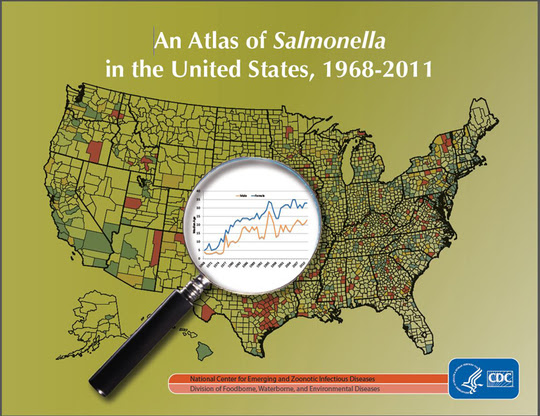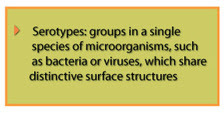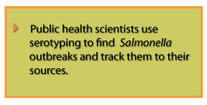New CDC Report:
Hands-On
Access to
Salmonella Data
40 Years and 32 Serotypes of Salmonella Data Available Online

March 2013 Special Edition

Fighting Salmonella: More Understanding = More Progress
An Atlas of Salmonella in the United States, 1968-2011 [PDF - 248 pages] is the first-of-its-kind report that charts over 40 years of laboratory-confirmed surveillance data on 32Salmonella serotypes. The report includes analyses by age, sex, season, and geography, down to the county level. This is the first time CDC has posted these data online in a downloadable format. (CDC published two earlier versions of the Atlas as books.)

CDC estimates that Salmonella causes about 1.2 million illnesses each year in the United States, with about 23,000 hospitalizations and 450 deaths.Salmonella most often causes vomiting or diarrhea, sometimes severe. In rare cases, Salmonella can cause severe and life-threatening bloodstream infections. Read more about Salmonella.
|

“Salmonella causes a huge amount of illness and suffering each year in the United States. We hope these data allow researchers and others to assess what has happened and to think more about how we can reduce Salmonellainfections in the future,” said Robert Tauxe, M.D., deputy director of CDC’s Division of Foodborne, Waterborne and Environmental Diseases. “The more we understandSalmonella, the more we can make progress in fighting it all along the farm to table chain.”
|  |

The Atlas allows users to explore
In addition to human infections, it also includes reports of Salmonella in animals in the environment and animal feeds, which can be sources of antibiotic resistant strains. Readmore about the importance of the Atlas.
The data presented likely represent just the tip of the iceberg since many infections fromSalmonella are not diagnosed and reported to the health department.
This may occur because
|


 Salmonella, Serotypes, and Serotyping
Salmonella has more than 2,500 different serotypes, but fewer than 100 cause the vast majority of infections in people. What we learn about the more common serotypes can increase our understanding of illness and the natural history of all the Salmonella strains. Read more about Salmonella and serotypes.
Since the 1960s, public health scientists in the US have used serotyping to help findSalmonella outbreaks and track them to their sources. Laboratory experts serotype theSalmonella from infected people. When cases with one serotype increase, they suspect an outbreak and disease detectives start their investigation.
|

 One of Salmonella'sNastiest Serotypes:Salmonella Enteritidis
Imagine a healthy looking, but infected, chicken that can lay eggs with contaminated yolk. Frightening, but true.Salmonella Enteritidis [PDF - 15 pages], one of the most common serotypes of Salmonellareported worldwide, is often linked to eggs. If a fertile egg is contaminated with SalmonellaEnteritidis, it infects the new chick. If the egg is for eating, and someone eats the egg raw, or undercooked, that unlucky person may be infected with Salmonella Enteritidis.
Since the 1990s, infection rates have decreased as the egg industry voluntarily placed controls on egg flocks and consumers have eaten fewer raw eggs. Still, large outbreaks have occurred. The US Food and Drug Administration (FDA) enacted the Egg Rule in 2010 to control Salmonella on egg farms; they also established safe handling and labeling requirements for shell eggs.
|
- To access the Atlas, please visit http://www.cdc.gov/salmonella/
reportspubs/salmonella-atlas/ index.html
- For more information on Salmonella, please visit: http://www.cdc.gov/salmonella/
- For more information on food safety, please visit: www.foodsafety.gov
Please follow @CDC_NCEZID on Twitter





















.png)









No hay comentarios:
Publicar un comentario